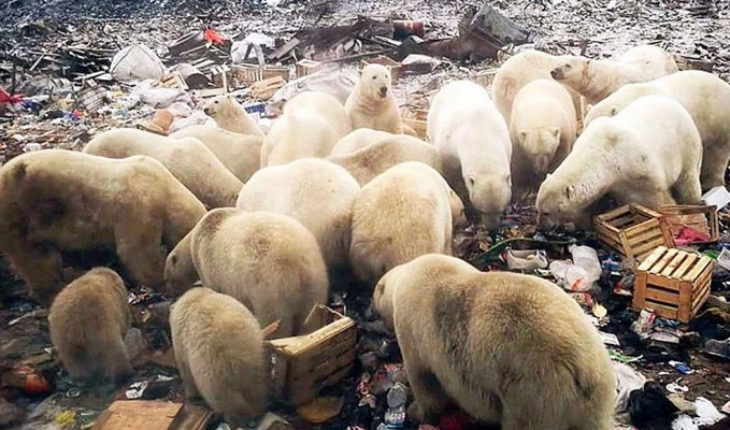photos / Internet Russia-this is a phenomenon that is being presented from the year 2018: polar bears seeking food between the garbage of a remote village in the Russian Arctic. The abrupt change of ecosystem – spend icy soil that melts to the rugged scenery of urban growth – considerably affects these specimens walking between the jaws of the waste.
In February, the presence of polar bears increased abruptly: more than 50 bears reached the village of Beluchia Guba in the archipelago North of Novaya Zemlya, in the Arctic from Russia, and at least 10, marched through the streets and entered several buildings.
Local authorities decreed the State of emergency for a week and asked for help to Moscow. The images of the incident toured the world, and some specialists blamed the authorities, mainly by the enormous waste tank to one side of the village, where the bears were a long time devouring what were.
However, experts in these animals pointed out that the fundamental cause that motivated the approximation of the bears to humans was late freeze-up of the sea, which forced them to seek alternative sources of food before the difficult task of hunting in their ecosystem main.
Russia increases its presence in the Arctic – in search of energy projects, the navigation of the North passage and strategic military interests – experts predict that there will be more unexpected encounters between humans and bears.
“The development in the Arctic definitely will increase conflicts with humans, especially now that polar bears are losing their platform of life in several regions,” said biologist Anatoly Kochnev, who has studied polar bears from the Decade of 1980.
Specialists blamed the authorities, mainly by the enormous waste tank to one side of the village, where the bears were a long time devouring what were Novaya Zemlya, an archipelago of two islands between the Kara Seas and Barents, is a good example of the new Russian border which is Centre of the natural habitat of polar bears. Bears in the Barents Sea are witnesses of a rapid reduction of the ice.
According to the Polar Bears International entity, this species has lost ice 20 weeks a year in recent decades. “The observation of ice shows that previously formed the ice near Beluchia Guba in December,” said Ilya Mordvintsev, of the Severtsov Institute in Moscow, one of the members of the team that collaborated on the ‘invasion’ of polar bears in the village.
“For thousands of years, the bears migrated at this time of the year to hunt seals. This year, however, they came to the coast and there was no ice”, he added. Even though ice has formed gradually since October–a time of greater number of bears – 2018, it is possible that this situation will arise. And, perhaps, in a not-too-distant time.
New Zembla had been a territory of nuclear tests at the time of the Soviet Union, even today it remains a territory of restricted access. Even so, the Russian military have built new buildings and an airstrip. A huge post is under construction, in support of plans to exploit lead and zinc mines.
Kochnev, for example, still remembers the damage caused by the Soviet defence staff missile which was parked on Wrangel Island in the Arctic. In 1991, soldiers wounded with an axe a bear that had gotten used to find food among debris from the military installation, and that, Furthermore, it had become very aggressive. The biologists of the nature reserve on the island never found the wounded bear.
According to Kochnev, currently instructions for polar bears concentrate more on how to chase them away in how prevent its presence in a habitat unsuitable for them.
In fact, one of the’ to know’ during a hypothetical stay in the village is the behaviour of polar bears and how to proceed before a meeting – something that, faced with the ecosystem alterations, seems inevitable-.
Mordvintsev pointed out that the development of the North passage also presents challenges for polar bears in the region. “The use of icebreakers in areas where seals take care of their offspring ends up affecting its population”, and this would affect the bears, given that, according to the current food chain, seals are their food.
Last year, President Vladimir Putin ordered an increase in the capacity of the North passage (bordering Siberia to the Bering Strait), from its current level of 18 million tons to 80 million in 2024.
According to Kochnev, polar bears have been able to adapt so far to adverse trends, and learned to hunt in small groups instead of individually. But the warming continues as an enemy who walks hand in hand with the survival instinct. “The bears will simply abandon Russia,” doom Kochnev.
“If ice-free period increases in two or three weeks, the bears probably migrated northward from Canada, where the changes are less evident”, said.
In that box, bears remaining in Russia will be extinct by human contact.
Source: Time





